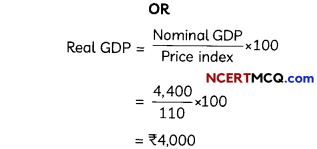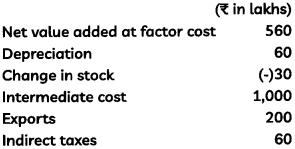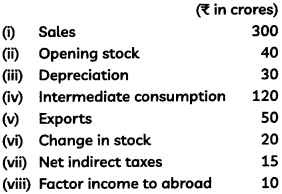Students can access the CBSE Sample Papers for Class 12 Economics with Solutions and marking scheme Term 2 Set 2 will help students in understanding the difficulty level of the exam.
CBSE Sample Papers for Class 12 Economics Term 2 Set 2 with Solutions
Time allowed: 2 Hours
Maximum Marks: 40
General Instructions:
- This is a Subjective Question Paper containing 13 questions.
- This paper contains 5 questions of 2 marks each, 5 questions of 3 marks each and 3 questions of 5 marks each.
- 2 marks questions are Short Answer Type Questions and are to be answered in 30-50 words.
- 3 marks questions are Short Answer Type Questions and are to be answered in 50-80 words.
- 5 marks questions are Long Answer Type Questions and are to be answered in 80-120 words.
- This question paper contains Case/Source Based Questions.
![]()
Question 1.
Distinguish between stock and flow variables.
OR
Distinguish between consumption goods and capital goods. (2)
Answer:
Any economic variable which is measured at a point of time is known as stock, e.g. capital, etc. Whereas, any economic variable measured during a period of time is known as flow, e.g. income, etc.
OR
Goods purchased for satisfaction of wants are consumer goods whereas Final goods that are used for producing other goods are capital good.
Question 2.
If the Marginal Propensity to Save is 20% and is constant at all levels of income and the autonomous consumption is ₹ 100 crores, construct consumption function of the given hypothetical economy.
OR
S = – 100 + 0.2 Y is the saving function in an economy. Investment expenditure is ₹ 5,000. Calculate the equilibrium level of income. (2)
Answer:
MPS = 20% = 0.2
and C = ₹100 crore
MPC = 1- MPS = 0.8
C = C + MPC(Y)
C = 100 + 0.8Y
OR
S = – 100 + 0.2 Y
At equilibrium S = I
I = 5000
5000 = – 100 + 0.2 Y
0.2 Y = 5100 Y
= ₹25500
![]()
Question 3.
Justify the following statement with valid reason.
“Ex-ante Aggregate Demand is always equal to Ex-ante Aggregate Supply.”
Answer:
Ex-ante Aggregate Demand is equal to Ex-ante Aggregate Supply only when the economy is in equilibrium. At under-employment equilibrium level, when Ex-ante Aggregate Demand falls short of Ex-ante Aggregate Supply, it will lead to accumulation of unplanned inventories. Hence the producer will reduce employment leading to reduction in output and income till the two forces becomes equal to each other and vice versa.
Question 4.
Discuss briefly the concept of informalisation of workforce’, in the context of Indian economy.
OR
The following table shows the population and worker population ratio for India in 1999-2000. Can you estimate the workforce (urban and total) for India? (2)
| Region | Estimates of Population (in crores) | Worker Population Ratio | Estimated No. of Workers (in crores) |
| Rural | 71.88 | 41.9 | 71.88/100 x 41.9 = 30.12 |
| Urban | 28.52 | 33.7 | ? |
| Total | 100.40 | 39.5 | ? |
Answer:
In the recent years, India has witnessed an unprecedented shift of the workforce from the formal sector to informal sector. This process whereby, the proportion of informal worker in the total workforce increases is known as informalisation of workforce.
OR
Estimated number of workers (in crores) for urban = (28.52 x 33.7)/100 = 9.61 crores Total workforce = 30.12 + 9.61 = 39.73 crores
![]()
Question 5.
“It is necessary to create employment in the formal sector rather than in the informal sector.” Defend or refute the given statement with valid arguments. (2)
Answer:
The given statement is true and can be defended on the following arguments:
- Formal sector of employment provides greater job security as compared to informal sector of employment.
- Under the formal sector of employment people are entitled to better social security benefits.
Question 6.
Giving reason, explain how the following should be treated in estimation of national income:
(A) Expenditure by a firm on payment of fees to a chartered accountant
(B) Payment of corporate tax by a firm
(C) Purchase of refrigerator by a firm for own use.
OR
If the Nominal Gross Domestic Product = ₹4,400 and the Price Index (base = 100) = 110. Calculate Real Gross Domestic Product. (3)
Answer:
(A) Payment of fees to chartered accountant by a firm is intermediate cost to the firm and, therefore not included.
(B) Payment of corporate tax by a firm is a transfer payment and thus not included.
(C) Purchase of a refrigerator by a firm for own use is investment expenditure and thus included.
OR

Question 7.
Analyse the trends in sectoral distribution of workforce in India on the basis of data:
Trends in Employment Pattern (Sector-wise), 1972-2012 (in %)

 Read the following text carefully and answer question number 8 and 9 given below:
Read the following text carefully and answer question number 8 and 9 given below:
A comparison of progress by India and China since their founding
Although India has made progress in every field in the last seven decades of its independence, the truth is that the neighboring country China is now far ahead of India on most social indicators, such as health, education, safe drinking water, electricity, livable housing conditions, and sanitation facilities. The whole world marvels at the unprecedented economic and social advancement China has achieved after the introduction of the landmark economic reform and opening-up policy in the late 1970s.
![]()
In the 1980s, India and China were on the same level as per the standard of the significant economic development scale, GDP. But now 40 years later, where is China and where is India? Although the Indian political establishment at the center always claims the country is a superpower, the truth is that what India has achieved pales in comparison with what China has accomplished in its poverty alleviation programme, iconic infrastructure projects and landmark innovations in science and technology over 70 years.
Since the outbreak of the novel coronavirus last year, the pandemic has been disturbing the economic activities in India, more and more people are falling below the poverty line every day. According to estimates by Pew Research, more than 75 million Indians have plunged back into poverty and more than 25 million people have lost their jobs since the start of 2021. As per the survey of the Centre for Monitoring Indian Economy published on July 8, 2021, in The Indian Express, around 150-199 million additional people will fall into poverty this year. It means an overall increase in poverty by 15¬20 percent, making around half of the country’s population poor.
On the other hand, despite being the first victim of the COVID-19 pandemic, China added 11.86 million new urban jobs across the nation in 2020. Over 60 million urban jobs were created in the past five years in China, according to Premier Li Keqiang’s 2021 Government Work Report.
https://news.cgtn.com/news/2021-08-19/A- comparison-of-progress-by-India-and-China- since-their-founding–12PM4eJjMlw/index.html
Answer:
The given data indicates that over the given period, the proportion of workforce in primary sector has gone down rapidly. Whereas, the employment share of both secondary sector and the services sector has increased. While the share of secondary sector (between 1993-94 and 2011-12) has gone up by approximately 9%, the corresponding figure for services sector has gone up by approximately 7%.
![]()
Question 8.
Is China growing faster than India? Elucidate. (3)
Answer:
Currently, China’s economy is estimated to be five times larger than India’s. China also continues to have higher economic growth rates each year as well as a higher overall GDP. Although India has made progress in every field in the last seven decades of its independence, the truth is that the neighboring country China is nowfarahead of India on most social indicators, such as health, education, safe drinking water, electricity, liveble housing conditions, and sanitation facilities. Although the Indian political establishment at the center always claims the country is a superpower, the truth is that what India has achieved pales in comparison with what China has accomplished in its poverty alleviation programme, iconic infrastructure projects and landmark innovations in science and technology over 70 years.
Question 9.
Analyse the impact of COVID-19 pandemic on India vis-a-vis the China in terms of poverty. (3)
Answer:
India has been hard-hit by the Covid-19 pandemic. The pandemic has been disturbing the economic activities in India, more and more people are falling below the poverty line every day. According to estimates by Pew Research, more than 75 million Indians have plunged back into poverty and more than 25 million people have lost their jobs since the start of 2021. An overall increase in poverty by 15-20 percent, making around half of the country’s population poor.
On the other hand, despite being the first victim of the COVID-19 pandemic, China added 11.86 million new urban jobs across the nation in 2020. Over 60 million urban jobs were created in the past five years in China
![]()
Question 10.
Sale of petrol and diesel cars is rising particularly in big cities. Analyse its impact on gross domestic product and welfare. (3)
Answer:
Final sale of cars raises GDP, because final sales are final products. Cars provide convenience in transportation but at the same time it causes traffic jams, air pollution and noise pollution reducing the welfare of the people. Pollution has bad effects on the health of the people.
Question 11.
Discuss the adjustment mechanism in the following situations:
(A) Aggregate demand is lesser than Aggregate Supply.
(B) Ex-Ante Investments are greater than Ex-Ante Savings. (5)
Answer:
(A) When Aggregate Demand is lesser than Aggregate Supply (AD<AS), buyers are planning to buy lesser goods and services than what producers are planning to produce.
It will lead to rise in planned inventories above the desired level. The producers in turn will produce less, which will reduce the income level i.e. AS. This process will continue till AD becomes equal to AS.
(B) Ex-ante investments are greater than ex-ante saving (I > S) means buyers are planning to buy more output as to what producers are planning to produce. It will lead to fall in planned inventories below the desired Level. As a result the producers will raise production, leading to increase in income till savings becomes equal to investments.
![]()
Question 12.
(A) Calculate sales from the following:

(B) State the four major sectors in an economy according to the macroeconomic point of view.
OR
(A) From the following data, calculate net value added at factor cost.

(B) What are the four factors of production and what are the remuneration to each of these called? (5)
Answer:
(A) Sales = Net value added at factor cost + Depreciation + Indirect taxes + Intermediate cost – Change in stock
= 560 + 60 + 60 + 1,000 – (-) 30
= ₹ 1710 lakh
(B) An economy is classified into the following four categories:
- Household sector
- Producing sector
- Government sector
- Rest of the world
OR
(A) NVAFC = Sales + Change in stock – Intermediate consumption – Depreciation – Net indirect taxes
= 300 + 20 – 120 – 30 – 15
= ₹ 155 crores
(B)
| Sr. | Factors of Production | Remuneration |
| (i) | Land | Ren |
| (ii) | Labour | Wages |
| (iii) | Capital | Interest |
| (iv) | Entrepreneurship | Profit |
![]()
Question 13.
(A) “Recently Indians have drifted away from the traditional knowledge and practices and caused large scale damage to environment”. Explain how, adopting the traditional practices can be helpful in achieving the objective of sustainable development?
(B) Children below 15 years of age and the old people beyond 60 years are not considered while counting the number of unemployed. Do you agree? (5)
Answer:
(A) The given statement is quite appropriate. Indian traditional practices were environment friendly and worked as complementary to the system and not its controller. The traditional agriculture system, healthcare system, housing, transport etc. were intrinsically environment friendly. The traditional practices used natural products and processes which are more or less free from side effects. For example by adopting medicinal plants/products we can conserve the resources and achieve the objective of sustainable development.
(B) Yes, I agree that children below 15 years of age and the old people beyond 60 years are not considered while counting the number of unemployed because these persons cannot become part of labour force even when they are able and willing to work.